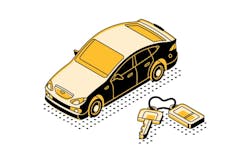As shop owners work to break through the many bottlenecks and challenges throughout the day, one very important task can be missed along the way: communication. Especially in a time where shop team members may not even see a customer face-to-face during the entirety of their service, virtual communication becomes more important than ever.
Although communication with a customer is especially critical after their vehicle has been repaired, connecting with the client is crucial throughout the entire process. If changes or updates are miscommunicated—or not communicated at all—there could be surprises when they come to pay. In this case, surprises are typically bad, and could leave the customer feeling upset or angry with your shop. And in the age of Google, bad reviews travel faster than good ones.
In order to avoid these surprises, as well as continue a relationship with customers after their visit, clear and constant communication through different mediums is a necessity. Communication during and after services creates a level of trust with customers, and opens up the bottleneck so easily closed by previous (and frustrated) vehicle owners who refuse to be left in the dark.
The Importance of DVI
It all comes back to digital inspections. During the process of a repair, the digital inspection becomes the most vital and useful form of communication.
The most significant issue in any service or repair industry is the lack of trust due to a lack of transparency, and a full digital inspection provides much needed clarity a customer deserves. Each customer is able to look at photos of exactly what is wrong in their vehicle, and they can also share those photos with their spouse or other family members for further discussion.
Digital inspections can also move beyond the current visit and into the next. That way, jobs that were not sold in the first visit can be revisited and compared to the photo of the previous service to showcase how the issue did in fact grow into a larger problem. This can work to create a stronger sense of trust with a customer and encourage them to continue to return.
Through digital inspections, customers are able to make educated decisions and feel as though they are active participants in their service and their visit.
Reaching Back Out
Once the vehicle is back in a customer’s garage, the job doesn’t end there. As a way to check in and make sure the customer is happy with their service, send a follow-up email, text or call. All three types of communication are important and serve different purposes. The customer will most likely respond to one of the three types of communication that works best for them.
This communication is vital because it may lead to a customer sharing a portion of their experience that was less than satisfactory. This issue can then be resolved or explained, possibly recovering the relationship and increasing overall customer retention. Even if the customer didn’t have any issues during their service, the fact that your shop reached out to them shows that your team cares about them as a customer.
The Rules of Texting
—
One important factor to keep in mind before reaching out to customers through text is the Telephone Consumer Protection Act (TCPA). The TCPA requires businesses to include an explicit opt-in before any text message marketing can take place.
This opt-in can be a pop-up on your website, a dedicated web page or a checkbox on appointment forms. But in order to legally send text marketing messages to customers, they need to first give you permission.



